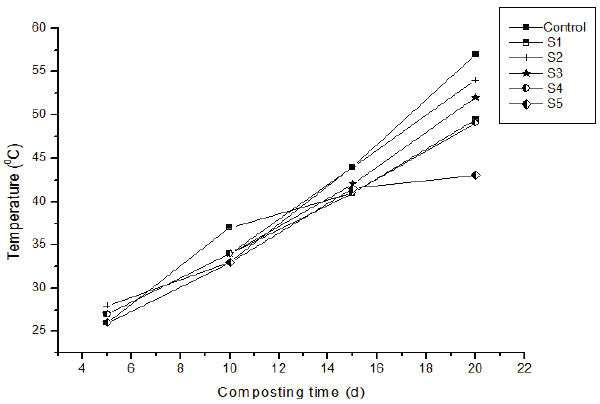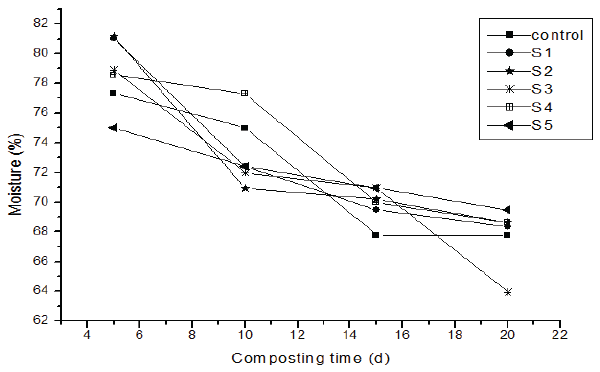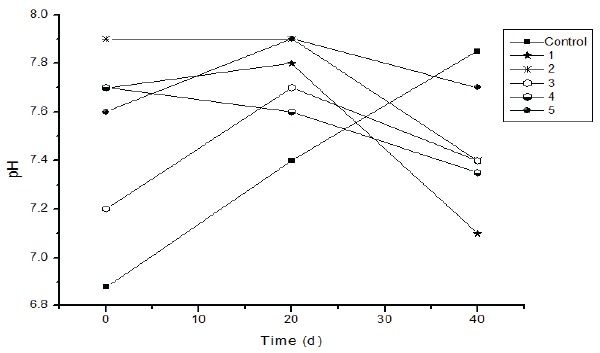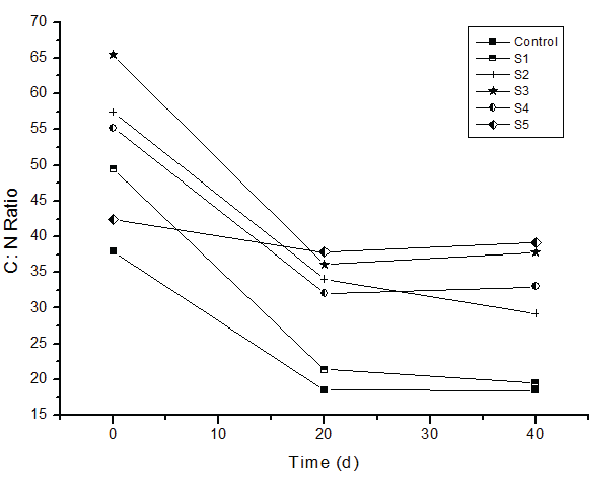Research Article Open Access
Potential of Microbial Inoculated Water Hyacinth Amended Thermophilic Composting and Vermicomposting in Biodegradation of Agro-Industrial Waste
| Alkesh Patidar*, Richa Gupta, Archana Tiwari | |
| School of Biotechnology, Rajiv Gandhi Proudyogiki Vishwavidhyalaya, State Technological University of Madhya Pradesh, Airport Bypass Road, Bhopal, India | |
| Corresponding Author : | Alkesh Patidar School of Biotechnology Rajiv Gandhi Proudyogiki Vishwavidhyalaya State Technological University of Madhya Pradesh Airport Bypass Road, Bhopal (M.P.), India Tel: +918269537372 Fax: 0755-2742002-3 E-mail: pati.ak9@gmail.com |
| Received April 27, 2013; Accepted June 24, 2013; Published June 26, 2013 | |
| Citation: Patidar A, Gupta R, Tiwari A (2013) Potential of Microbial Inoculated Water Hyacinth Amended Thermophilic Composting and Vermicomposting in Biodegradation of Agro-Industrial Waste. J Bioremed Biodeg 4:191. doi: 10.4172/2155-6199.1000191 | |
| Copyright: © 2013 Patidar A, et al. This is an open-a ccess article distributed under the terms of the Creative Commons Attribution License, which permits unrestricted use, distribution, and reproduction in any medium, provided the original author and source are credited. | |
Related article at Pubmed Pubmed  Scholar Google Scholar Google |
|
Visit for more related articles at Journal of Bioremediation & Biodegradation
Abstract
Potential of Streptomyces viridosporus , Aspergillus niger and Moraxella osloensis combination in thermophilic composting followed vermicomposting of jatropha seed cake with 2:1 ratio of Water Hyacinth (WH) and Cow Dung (CD) was tested. Significant decrement in MC, TOC, and C: N ratio and increment in temperature, TP was observed. TKN, pH and TK were first increases in composting and then decreased in vermin composting. Most stable and matured vermin compost was obtained in S1 substrate in terms of C: N ratio below 20 (19.50 ± 1.10). Maximum earthworm number (47 ± 6), maximum net biomass worm −1 (150 ± 15.6) obtained in S3 substrate and maximum cocoons (23 ± 2) were counted S1 substrate. 20% (w/w) vermin compost amended soil induced the growth in root length, shoot length and 100% GI while >20% (w/w) was inhibitory for plant growth. This approach decreases time period of degradation and produce good quality vermin compost if mixed up to 20%.
| Keywords |
| Jatropa seed cake; Vermicompost; Perionyx excavates; Inoculation |
| Introduction |
| India has huge biomass of agro-industrial processing waste viz. food processing, pulp and paper, rice husk, cotton dust, jatropa seed cake, viticulture and winery waste, sugarcane trash, guar gum industrial waste, but the capability of these organic resources is not fully utilized, and disposal of these wastes through incineration, open dumping and land filling, raises serious human health risk and environmental issue [1]. For future biodiesel production from the non-food biodiesel crop in southern Asia and Africa, Jatropa curcas is cited as one of the best candidates [2]. But the processing of jatropa seed produce 0.68 million tons of seed cake (at the rate of 65% oil recovery with 3 tons/ha oil yield), which is quite a significant amount. Jatropha seed cake cannot be used as animal feed because of its toxic properties. It has been reported to possess phorbol esters, a potential toxic compound to animals. Toxicity of J. curcas seeds has been studied extensively in different animals like goat, sheep, mice, rats and fish. Decrease in glucose level, lack of appetite, diarrhoea, dehydration and other hemorrhagic effects in different organs were the common observations when animals were fed on phorbol ester containing feed [3-5]. Generation of huge amount of biomass also pose serious threats to environment. |
| Due to high nitrogen content, jatropa seed cake can be processed into organic fertilizers via microbial thermophillic composting which is a technique that has been used to address the issues of environmental pollution, non-reliance on chemical fertilizers, sustainable natural soil fertility, and minimizing the development of new dumps and landfills [6]. In recent times, interest in the use of a closely-related technique, known as vermin composting (using earthworms to breakdown organic materials) has increased [7]. Industrial wastes that are rich in organic matter and free from toxic substances or ions could be suitable substrates for vermin composting [8]. A combine approach of composting and subsequent vermicomposting brings the advantages of both process and minimizes the adverse impact of waste on the environment. The product obtained with desirable characteristics and at a faster rate than either of the individual processes [9]. Through composting the required temperature for ensuring satisfactory pathogen kill would be achieved and product passes EPA rules for pathogen reduction. Through vermin composting, the rate of decomposition of organic materials increased and microbially active casts would be achieved. |
| Although, the microbial community naturally present in wastes usually carries out the process satisfactorily, the inoculation of residues with lingocellulolytic microorganisms is a strategy that could potentially enhance the way the process takes place or the properties of the final product. Inoculation with bacteria and fungi which can break down ligno-cellulolytic material has been reported to be effective in composting [10]. Inoculation increases cellulase activity, promote biodegradation of organic matter and accelerate the composting process [11,12] showed that mixed inoculation with complex microorganisms and ligno-cellulolytic microorganisms during composting of municipal solid waste had a clear advantage over inoculation with complex microorganisms or lingo-cellulolytic microorganisms alone. |
| Water hyacinth (Eichhornia crassipes (Mart) Solms - Laubach; family: Pontederiaceae) has been listed as most troublesome weed in aquatic systems. One of the easiest ways to utilize water hyacinth is to subject it to composting. Water hyacinth compost has been shown to have positive effect on plant growth. Research conducted by Umsakul et al. [13] showed that agro-industrial waste should be mixed with water hyacinth for composting to facilitate the development of thermophilic phase during the composting and to improve the product. |
| This present study was conducted to investigate the efficiency of water hyacinth and mixed microbial inoculation in biodegradation of industrial waste (Jatropa seed cake) during integrated composting and vermin composting technology. The objective of this study was to evaluate physical, chemical and biological parameters to determine the stability and maturity of composts prepared by mixing water hyacinth and cow dung in agro-industrial wastes. |
| Materials and Methods |
| Microbial source |
| The fungal strains A. niger, S. viridosporus and the bacterial strain M. osloensis were procured from IMTECH, Chandigarh, India. The fungi A. Niger and S. viridosporus were maintained by subculturing them on czepek yeast extract agar and trypton yeast extract respectively whereas bacteria was subcultured on tryptone yeast extract medium. |
| Industrial wastes (IW) |
| Jatropa seed cake (IW) was obtained from biodiesel plant at RGPV Bhopal. |
| Water hyacinth, cow dung and earthworm |
| Water Hyacinth (WH) was collected from the Lake situated in Bhopal. Cow manure (CD) was procured from a nearby poultry farm. Earthworms, Perionyx excavatus, used in this study came from the experimental farm of the Agronomic. |
| Experimental set-up |
| Different proportion of six feed mixture of industrial waste (Jatropa seed cake) was mixed in 2:1 ratio of CD and WH including one with CD and WH only were established (Table 1). Five kilogram of mixture (dry weight) was put in each rectangular pit (1 m length×1 m width×1 m height). A combination of pure cultures of A. niger and S. viridosporus (500 g mycelium per ton substrate) and M. osloensis (50 ml/kg substrate having 106 cells per ml) were inoculated in each pit on first day of composting. These mixtures were turned over manually every 24 h for 20 days in order to eliminate volatile substances potentially toxic to animals. The substrate with different treatments was pre-decomposed, in triplicates, for 20 days. |
| Subsequent vermicomposting |
| After 20 days, 20 adult individuals of Perionyx excavatus were introduced into each pit and then subjected to vermin composting for 20 days. The moisture content was maintained at 70 ± 10% of water holding capacity by periodic sprinkling of an adequate quantity of water. A plastic pipe with upper cap was installed in the middle of each bed and brought out of the ground through the tied mouth of the bag, in order to measure the temperature during composting. The temperature was measured daily by placing the thermometer through the plastic pipe. The earthworms and cocoons were removed manually and the vermin compost was chemically analyzed. |
| Compost sampling |
| Homogenized samples of the feed material were drawn at 0, 20 and 40 days from each pit. The zero days refers to the time of initial mixing of the industrial wastes with cow dung and water hyacinth before preliminary decomposition. |
| Compost analysis |
| The pH of the compost was determined in distilled water with 1:10 (w/v) compost: water ratio. The moisture content was measured by drying to constant weight in an oven at 105°C. Changes in the temperature of the compost pile were recorded using mercury thermometer. The mean of the pile temperature at two monitoring points is recorded. Total Kjeldahl Nitrogen (TKN) and Total Organic Carbon (TOC) of the pre-decomposed bio inoculated residue and the vermicompost were measured with the Micro-Kjeldahl method [14] and Walkely and Black [15] Rapid titration method (1934). Total phosphorus (TP) was determined spectrophotometrically [16]. Total potassium (TK) was detected by the flame emission technique by Flame photometer [17]. |
| Germination assay |
| Impact of most stable and matured vermin compost in terms of C: N ratio below 20 was tested on germinated seeds of cress plant. The amendments of vermin compost with garden soil were carried out at different concentrations (0, 20, 40, 60 80 and 100%). A control of garden soil was also used. Different concentrations of vermicompost amended soils (2.5 kg) were filled in different plastic pots. The soaked and sterile 30 cress (L. sativum L.) seeds were evenly sown in each pot to a depth of 2 inch. Prior to sowing, the cress seeds were sterilized in 3% formalin for 5 min to avoid any fungal contamination, washed thrice with double distilled water and soaked overnight in water. Experiments were conducted in triplicate with a parallel set of control. All the pots were watered daily till seed germination. All the pots were kept in a natural condition with an average durable temperature (25-35°C) and low humidity (50-55%). The germination index (GI) was calculated by the method reported by Fuentes et al. [18]. Subsequently, the plants were harvested after 5 days of sowing and repeatedly washed with tap water to remove any attached particles. Furthermore, these were rinsed with 10 mmol CaCl solution along with washing with deionised water. Root length, shoots length was measured manually using an inch-scale immediately after harvesting. |
| Statistical analysis |
| Results are the means of three replicates. One way analysis of variance (ANOVA) was done using the SIGMASTAT programme. The objective of statistical analysis was to determine any significant differences among the parameters analyzed in different treatments during the composting and vermin composting process. |
| Results and Discussion |
| Physico-chemical parameter |
| The physico-chemical characteristics of industrial waste, water hyacinth and cow dung are given in Table 2. |
| Changes in Temperature and Percent moisture content during composting are given in Figures 1 and 2. An initial temperature in the range of 26-28°C was noted in all five substrates and in control. Final temperature of 54°C in S2 and 54°C in control was recorded at 20th day of composting. It has been previously reported that the increase of temperature in the early phase of composting may be the result of thermophilic phase of composting. The temperature rise as a consequence of the rapid breakdown of organic matter, mostly readily available substrate rich in carbon, by microbial metabolism [19]. |
| Moisture content is an important factor in degradation because it influences the structural and thermal properties of the material, as well as the rate of degradation and metabolic process of microorganisms. Initial moisture content was in the range of 81.15-75 on 5th day of composting. Final moisture content was decreased and in the range of 63.93-69.49 in all the treatments. Lowest percentage was noted in S3 treatment. After composting of jatropa seed cake pH was increased in all the treatments and after vermin composting on 40th day it was decreased (Figure 3). Increase in pH during composting during composting was due to mineralization of the nitrogen and phosphorus into nitrites/nitrates and orthophosphates. The decrease in pH during vermicomposting may be due to CO2 and organic acids produced by microbial metabolism [20]. |
| Total Organic Carbon (TOC) decreased significantly in all treatments during composting and subsequent vermin composting, extremely in S1 and S2 which contained lower concentrations of industrial wastes. It may be due to the mineralization of organic matter [21]. During composting maximum carbon loss of 11.84% was noted in S1 treatment and least was 1.98% in S5 treatment (Table 3). This decrement was due to combined potential of added microbes and water hyacinth both initiate the thermophilic phase of composting. During vermin composting maximum carbon loss of 7.9% was noted in S2 and least was 1.92 in S3. It was the action of Earthworms which break and homogenizes the ingested material through muscular action of their foregut and, also adds mucus and enzymes in ingested material, this increase the surface area for microbial action. Thus action of water hyacinth earthworms and microorganisms bring TOC loss from the substrates in the form of CO2 [22]. |
| Percentage loss in carbon during composting was fast as compared to that of the vermin composting and it was due to higher initial N concentration, which might have increased the microbial activity in composting phase [23]. |
| During composting phase significant increment in TKN at 20th day was noted. Maximum percentage of TKN increment was noted in S1 treatment which receives the 80% of 2:1 ratio of cow dung and water hyacinth (Table 3). This increment might be due to potential of water hyacinth which facilitate and initiate the development of thermophilic phase during the composting process [13] and the inoculated microbes especially moraxella osloensis which fix the nitrogen present in the substrate. During subsequent vermin composting nitrogen content was decreased in all the treatments possibly due to ammonification, NH3 volatilization and denitrification as reported by Bernal et al. [24]. |
| C: N ratio-index of compost maturity |
| The C: N ratio of a substrate material reflects the organic waste mineralization and stabilization during the process of composting and vermin composting. The loss of carbon as CO2 through microbial respiration and simultaneously addition of nitrogen by worms in the form of Mucus and nitrogenous excretory material lower the C: N ratio of the substrate [25]. C: N ratio is considered as a parameter to establish the degree of maturity of compost and its agronomic quality [26]. Decline of C: N ratio to less than 20 indicates an advanced degree of organic matter stabilization and reflects a satisfactory degree of maturity of organic wastes [27]. Microbial composting and vermin composting of jatropa seed cake resulted in a loss of carbon because of mineralization of organic waste (Figure 4). Initial C: N ratio was in the range of 37.89-65.47 at zero days in different substrates. The initial C: N ratio was more in those feed mixtures which had higher percentage of jatropa seed cake. After composting and vermincompostubg C: N ratio was in the range of 18.59-37.82 and 18.46-39.11 respectively. Maximum decrement in C: N ratio was observed in S1 substrate comparable to control (P<0.001). The decomposition of the waste during vermicomposting was slow compared to that of the composting and might have been due to higher initial N concentration, which might have increased the microbial activity in the beginning, thus decreasing the C/N ratio [23]. |
| Percentage of total phosphorus was increased significantly during composting and vermicomposting in all the treatments with respect to control (P<0.001). The overall percent increase in the TP content was maximum in the substrate S3 (1.71 ± 0.10), and minimum percent increase was in the substrate S5 (0.65 ± 0.20) (Table 4). Yadav and Garg [28] noticed 1.5-2-fold increase in total phosphorus from industrial sludge vermicomposting. Lee [29] states that when organic material passes through the gut of earthworm then insoluable phosphorus is converted to soluable form by phosphatase produced within the earthworm and secreted by inoculated microbes which is easily available to plants. |
| Data in Table 4 reported that total potassium during microbial composting increase significantly in all the treatments as well as in control (P<0.001). Maximum increment was noted in S3 substrate (1.57 ± 0.15) and minimum was in S1 substrate (0.72 ± 0.10). However, we observed a marginal decrease in potassium during vermicomposting. Only S1 substrate showed slight increment in TK. This decrement in potassium was supported the result of Kumar et al. [30] who reported lower K content in sugar-cane waste by-products after vermicomposting. There are contradictory reports regarding the potassium content in vermicompost obtained from different substrates. Hait and Tare [31] have reported higher potassium content in the sewage sludge vermicompost. |
| This difference in potassium content can be attributed to the differences in the chemical nature of substrate. This might be also due to leaching of potassium by excess water that drained through the feeds. Benitez et al. [32] have reported that the leachate collected during vermicomposting process had higher potassium concentrations. It has been suggested that earthworm processed residue contains higher concentration of exchangeable K due to enhanced microbial activity during vermicomposting, which consequently enhances the rate of mineralization [25]. |
| Total no. of earthworm, cocoons and biomass |
| The different pattern of earthworm number and cocoons production depending on the percentage of substrate in the feed mixtures was observed after vermicomposting of jatropa seed cake (Table 5). Maximum earthworm number was observed in substrate S3 and maximum cocoons production was noted in S1. The addition of industrial waste up to 40% in cow dung and water hyacinth was found significant in cocoon production, but concentration above this level was not able to support the cocoon production. The increase in earthworms’ growth may also be attributed to a low C: N ratio of the microbial composted easily consumable water hyacinth added substrate [8]. Fayolle et al. [33] suggested that food source play an important role on cocoon production rates by worms. |
| The maximum net biomass production by Perionyx excavatus was observed in substrate S2 (150 ± 15.6 mg earthworm-1) and lowest in S5 substrate (53 ± 15.2 mg earthworm-1). Increasing percentage of jatropa seed cake in the feed mixtures resulted in a decrease in biomass of earthworm. It is concluded from the results that addition of 40% jatropa seed cake to the water hyacinth and cow dung is acceptable during the vermicomposting in terms of growth and reproductive success of the earthworms. |
| Biological parameter of vermicompost analysis |
| The evaluation of industrial wastes toxicity by chemical characterisation and biological testing is extremely important for screening the suitability of vermicompost for land application. To evaluate the biological parameter of vermicompost, the amendment of most stable and matured compost on the basis of C: N ratio less than 20, substrate S1 with garden soil were carried out at different concentrations (20, 40, 60, 80 and 100%). In general, percentage of seed germination decreased with increase in vermicompost concentrations from S1a to S1e (Table 6). In present study, it was observed that up to 20% (w/w) concentration of vermicompost has no inhibitory effect on seed germination while at higher concentration (>40%), decrease in percent germination was recorded. This decrease in percent germination except in control and 20% vermicompost was due to phytotoxic effect produced by combination of several factors, rather than one [34]. These factors include the presence of heavy metals, ammonia, salts, and low molecular weight organic acids [18] all of which have been shown to have inhibitory effects. |
| The vegetative growth parameters of cress plant (shoot length and root length) at all tested concentrations showed significant inhibitory effect (except 20% vermicompost amended soil) versus the control (Table 7). Maximum root length was noted in S1a trial (3.6 ± 0.12). Similarly maximum shoot length was observed in S1a trial (5.6 ± 0.14) more than the control. As the concentration of vermicompost increased root and shoot length was decreased. It has been reported that high vermicompost content was suppressive for plant growth hormone (s) (auxin and gibberline) which are responsible for the growth and development of plants [35]. The reduction in plant growth at high concentrations of vermicompost might be due to the entrance of the metal into the protoplasm resulting in the loss of intermediatory metabolites which are essential for further growth and development of plants. These findings are very much in accordance with the earlier reported results [36]. |
| Conclusion |
| The chemical analyses of the compost produced by microbial inoculated composting and vermicomposting of jatropa seed cake admixed with water hyacinth and cow dung, point towards its patentability. On the basis of C: N ratio below 20, earthworm biomass, growth and reproduction, results demonstrated that after the addition of jatropa seed cake (20%) in 2:1 ratio of water hyacinth, cow dung, and inoculated microbes, S. viridosporus, A.niger and M. osolensis, it can be used as a raw material. Germination index using cress seeds showed that concentration above 20% of vermicompost had inhibitory effect and cause phytotoxicity. |
| Acknowledgements |
| Author would like to thank the Indian institute of soil science for help with the compost analyzing. |
References
|
Tables and Figures at a glance
| Table 1 | Table 2 | Table 3 | Table 4 |
| Table 5 | Table 6 | Table 7 |
Figures at a glance
 |
 |
 |
 |
| Figure 1 | Figure 2 | Figure 3 | Figure 4 |
Relevant Topics
- Anaerobic Biodegradation
- Biodegradable Balloons
- Biodegradable Confetti
- Biodegradable Diapers
- Biodegradable Plastics
- Biodegradable Sunscreen
- Biodegradation
- Bioremediation Bacteria
- Bioremediation Oil Spills
- Bioremediation Plants
- Bioremediation Products
- Ex Situ Bioremediation
- Heavy Metal Bioremediation
- In Situ Bioremediation
- Mycoremediation
- Non Biodegradable
- Phytoremediation
- Sewage Water Treatment
- Soil Bioremediation
- Types of Upwelling
- Waste Degredation
- Xenobiotics
Recommended Journals
Article Tools
Article Usage
- Total views: 14719
- [From(publication date):
June-2013 - Apr 03, 2025] - Breakdown by view type
- HTML page views : 10018
- PDF downloads : 4701
